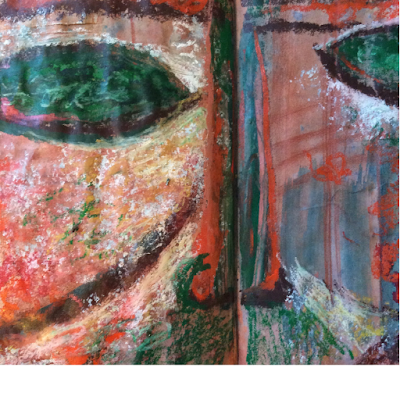Module SIX – Chapter 7 – USE OF DISSOLVABLE FABRICS
1 – TECHNICAL SAMPLES USING ONE TYPE OF STITCH METHOD
The photo below shows my technical samples of stitching on six different water soluble materials. The first three samples from left make use of fabrics I bought some years ago – Avalon, Solufleece and Soluweb – while the second group towards the right shows products that are more recent developments of the industry – Romeo, Guilletta and Water Soluble Paper. I stitched the same patterns on all of them: straight and zigzag stitch grids both in regular and free stitchery plus some other simple drawings.
PHOTO ONE – samples before dissolving

PHOTO TWO: Avalon Soluweb and Solufleece after dissolving

PHOTO THREE: Guilletta Romeo and Water Soluble Paper after dissolving

All in all it does not seem to me that samples obtained are so different in appearance or quality. What it DOES change is the easiness of working on the newer materials: they are more stable, it is possible to draw on them – drawing on the water soluble paper is particularly nice - Romeo and Guilletta are both transparent and this is so useful when there is a need to follow lines or patterns placed underneath; Guilletta is lighter and less expensive, Romeo is more substantial but both can be used without a hoop – in case of heavy stitching Guilletta can be doubled - and I find this invaluable. Being thicker Romeo dissolves less quickly and this can be useful if a more rigid final effect is wished. Water soluble paper samples show some residues still trapped in the stitchery for a different effect.
2 - SAMPLES OF SOLUBLE LACE USING DIFFERENT STITCH METHODS
For this second series of samples I used only Guilletta and Romeo films without a frame. The numbers placed beside each of them follow the very useful system suggested by Sian.
1: regular stitching, 2: free stitching, 3: very open, 4: very dense, 5: only one direction, 6: opposite directions, 7: curved shapes, 8: straight stitch, 9: zigzag stitch, 10: cable stitch, 11: whip stitch, 12: metallic thread, 13: trapped bits

3 – SOLUBLE LACE SAMPLES BASED ON SEA AND SKY DRAWINGS
Guilletta is the film used for these samples. All measure approximately 10-12 cm on each side and some incorporate fragments of chiffon. I placed all of them on a white or cream background to show how they are look on their own, then on a coloured fabric to have a first idea of how these laces could be combined in a more complex way.
Before each of them there is the drawing on which it is based. Drawings are quite small in reality – squares of 4 cm – but I enlarged them to see patterns more clearly. I used mainly the same drawings of Chapter SIX in order to see how they translate both in cutwork and free lace.
SAMPLE ONE

Straight stitch only

DETAIL ON BLACK BACKGROUND

SAMPLE TWO

Zigzag and straight stitch


SAMPLE THREE

This sample is actually a combination of three in white, blue and green then interlaced and overlapped.

DETAIL ON BLUE BACKGROUND

SAMPLE FOUR


DETAIL ON A MOTTLED PAPER

SAMPLE FIVE


DETAIL ON A BLUE FABRIC



Brilliant set of samples, I really love the lace ones, samples 4 and 5 are beautiful, in their interpretation of the sketches, which are also super, and their colour pallets. As usual you have come up with something really different and inspiring.
ReplyDeleteYour samples are amazing and beautiful, Daniela. I can't tell you which one I prefer
ReplyDeleteLovely samples, Daniela
ReplyDeleteThese are just lovely Danni - so delicate.
ReplyDeleteThese are beautiful Daniella. This is one of my favourite techniques, always full of surprises.
ReplyDeleteThese samples look absolutely gorgeous, I thought the comparison set you did at the beginning was really interesting, but the larger colour samples are quite wonderful.
ReplyDelete